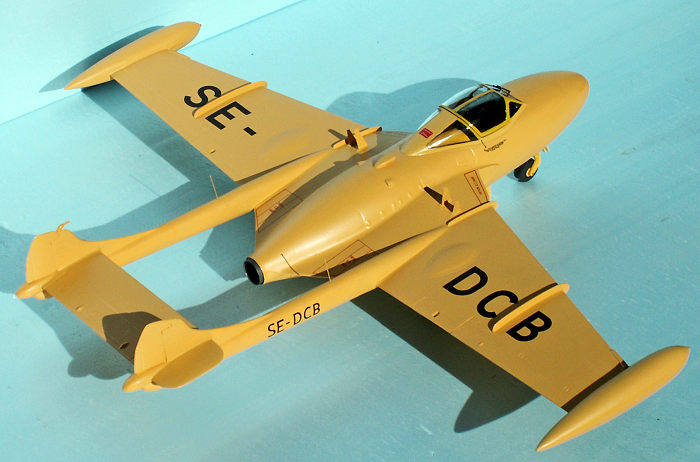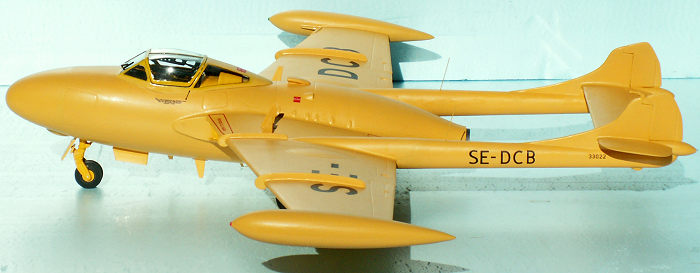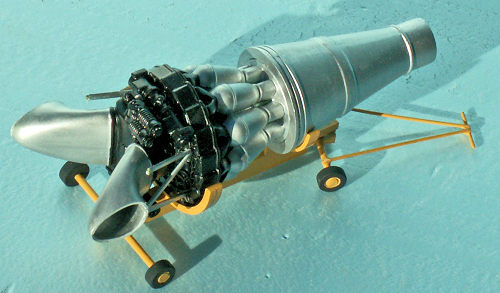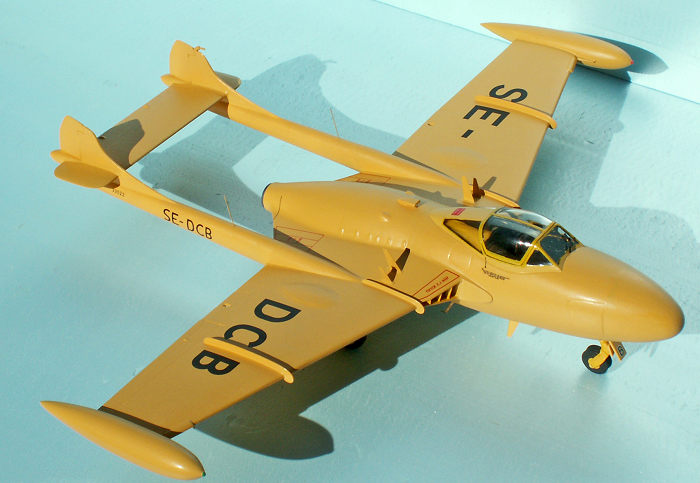
Revell 1/32 Sea Venom
| KIT #: | 04709 |
| PRICE: | $15.00 |
| DECALS: | Three options |
| REVIEWER: | Torben Plesberg |
| NOTES: | Swedish civil Venom ex J 33 Flygvapnet. Matchbox rebox. |

| HISTORY |
The two seat Venom was developed from the single seat Vampire fighter bomber and the two seat Vampire trainer as a private venture of De Havilland. Its construction was of wood and metal just like the famous Mosquito from WW II. The plane was offered as a night fighter and for carrier born operations under the name Sea Venom. The power plant was a De Havilland Ghost engine, a development of the Goblin offering a 50% increase in static thrust.
The Venom looks like the Vampire with its single engine and twin boom tail, but has a new wing with a straight trailing edge and wing tip tanks increasing the internal fuel capacity by almost 100 %. The Venom was faster than the Vampire and had an excellent rate of climb. Armament was four 20 mm cannons and provision under the wings for rockets or bombs. The Sea Venom had an arrester hook in a specially designed rear fuselage. Besides it had a different canopy allowing the pilot to sit higher for a better view during carrier landings.
 After
WWII Sweden switched to jet propelled aircraft for the air force – Flygvapnet.
The Swedish SAAB company developed new jet fighters, the J 29 Tunnan and the J
32 Lansen, but was unable to deliver soon enough. Therefore, Sweden had to buy
foreign jets until the SAAB fighters were available. The pilots got their
initial jet training flying the SAAB J-21R, the first Swedish jet fighter to
emerge. Krigsflygskolan, F 5 later got the two seat J 28C Vampire T 55, and a
fair number of single seat J 28A & B Vampire fighter bombers were purchased for
the fighter bomber wings. Denmark had the same problem as Sweden concerning new
jet fighters, however, Denmark chose the twin engine Gloster Meteor Mk 4 as
their first jet fighter.
After
WWII Sweden switched to jet propelled aircraft for the air force – Flygvapnet.
The Swedish SAAB company developed new jet fighters, the J 29 Tunnan and the J
32 Lansen, but was unable to deliver soon enough. Therefore, Sweden had to buy
foreign jets until the SAAB fighters were available. The pilots got their
initial jet training flying the SAAB J-21R, the first Swedish jet fighter to
emerge. Krigsflygskolan, F 5 later got the two seat J 28C Vampire T 55, and a
fair number of single seat J 28A & B Vampire fighter bombers were purchased for
the fighter bomber wings. Denmark had the same problem as Sweden concerning new
jet fighters, however, Denmark chose the twin engine Gloster Meteor Mk 4 as
their first jet fighter.
The Swedes flew the J 30 Mosquito in the night fighter wing F 1. However, the Mosquitos had a high accident rate and were due to be retired. The successor was chosen to be the two seat Venom F 51. Sixty J 33 Venoms were ordered by the Swedish government, and the planes were flown to Sweden in 1953 and 1954 by Swedish pilots, who were checked out on the Venom in Britain – this was a part of the contract. Fifty nine Venoms arrived in Sweden, one was lost in Britain shortly after take off.
The Venom did a good job with the F 1 wing of Flygvapnet. They were an important part of the Swedish defense, the most obvious aggressor would be the Soviet Union, especially after the shooting down of a Swedish Tp 79 Dakota and a Tp 47 Catalina in 1952 by Soviet MiG 15 fighters! A pair of Venoms were always alert and ready to take off within a few minutes in the dark hours.
When the
Venoms were retired after some six years of operation, they were replaced by the
SAAB J 32 Lansen. which was classified as an FAW. Interesting, that a smaller
number (32) succeeds a larger number ( 33). However, both the Lansen and the
Tunnan had got their numbers before the Venoms were acquired. The number 31 was
allocated to the Spitfire S 31(PR Mk 19). Hence, 33 was the next “free” number
for a new plane in Flygvapnet.
33). However, both the Lansen and the
Tunnan had got their numbers before the Venoms were acquired. The number 31 was
allocated to the Spitfire S 31(PR Mk 19). Hence, 33 was the next “free” number
for a new plane in Flygvapnet.
The Venom night fighters were phased out in 1960, however, four planes were sold to Svensk Flygtjänst AB, two of these already in 1958. The planes were used for target towing and some other tasks, including radio control of the Australian Jindivik Mk II missile. The Venoms got civil registrations: SE-DCA, B, D and E. They were painted yellow, just like the Firefly and the Skyraider target tugs. The Venom continued service for almost ten years, and DCA, C and E were retired in 1969, whereas the B got two more years in service, and became the last flying Venom in Sweden.
The DCD was preserved and painted as a night fighter from F 1, Erik blå (blue) and can be seen in the Flygvapen Museum at Malmen. The DCA was also kept, and many years later preserved and exhibited in Västerås Flygmuseum, as a civil Venom TT of Svensk Flygtjänst.
| THE KIT |
The kit comes in a fairly large box, which opens in the Revell way - the ends, meaning that it is less suited for keeping the parts during construction. There are six sprues in a white styrene and a clear sprue with the canopy parts. The instructions is an A4 booklet of twelve pages. Page one is a short history of the Sea Venom FAW 22/ NF 3 in German and English. Page two contains some advice before the construction. Page three explains the symbols used in the construction guide and page four explains which Revell colors should be used for the model. Pages five to eight shows the sprues with numbered parts and fifty two steps for the construction of the kit. Pages nine to eleven show how to paint and decal the three options of the kit.
The
decal sheet is large and with three options: Sea Venom FAW 22 of the Royal Navy
894 NAS HMS Albion
 1960, Sea Venom FAW 53 of the 724 NAS HMAS Melbourne Royal
Australian Navy 1962, and Venom F 3 sqd. 89 RAF Stradishall 1955-58. The decal
sheet seems to be of a high quality, but I did not use it.
1960, Sea Venom FAW 53 of the 724 NAS HMAS Melbourne Royal
Australian Navy 1962, and Venom F 3 sqd. 89 RAF Stradishall 1955-58. The decal
sheet seems to be of a high quality, but I did not use it.
The kit is of a reasonable quality, however, it is an old kit originally tooled by Matchbox with a lack of all fine details of the airframe. It is a large kit and the finished model has an impressive size. The Ghost engine is rather detailed and should be shown outside the airframe. It is a waste of time to build it into the model. Besides you might get problems to assemble the fuselage, as I realized. Such sub-assemblies are often not accurate enough to be build in.
There are some alternative parts to be applied for a Sea Venom or a night fighter Venom, most noticeable the arrester hook arrangement. Also the hood of the canopy is different, that of the Sea Venom has a bulge in the port side allowing the pilot a higher view over the nose for a safe carrier landing.
| CONSTRUCTION |
If you read Swedish, it is a good idea to get a book by Mikael Forslund: J 33 De Havilland Venom NF 51. Forslund is a keen modeler and gives in a chapter a very thorough description of his built of the Venom from the Matchbox kit. It is not possible to get a more accurate source for a Swedish night fighter Venom!
The kit may be built as a Sea Venom FAW 22/53 or as a night fighter NF 3. I chose the night fighter, and even in the civil edition of Svensk Flygtjänst AB. The parts of the kit, however, are not enough to create the Swedish night fighter, and certainly not the civil Venom.
In the following, I shall mainly deal with the special items for the Swedish night fighter according to Forslund’s advice:
 The
cockpit is quite different from the British Venoms. It is a “discount” edition
without ejection seats for the safety of the pilot and systems operator. This is
a most obvious difference. The book contains a lot of sketches and photos
showing all the detailing of the Venom, including the cockpit arrangement. Some
modelers take the trouble to super detailing the cockpit, however, Forslund did
not and I neither. Only the most prominent parts were built, and painted before
the assembly of the fuselage.
The
cockpit is quite different from the British Venoms. It is a “discount” edition
without ejection seats for the safety of the pilot and systems operator. This is
a most obvious difference. The book contains a lot of sketches and photos
showing all the detailing of the Venom, including the cockpit arrangement. Some
modelers take the trouble to super detailing the cockpit, however, Forslund did
not and I neither. Only the most prominent parts were built, and painted before
the assembly of the fuselage.
The elevator must be elongated outside the booms by some 1.5 cm. These parts were made of Ureol, artificial wood, and must conform with the fin bulges to fit properly. The pitot tube placed on the top of the left fin is too bad and must be replaced by a scratch-built one of metal tubing and wire. The slots of the engine air intakes are too thick and must be sanded thinner – or cut off and replaced by new ones made of 0.75 mm plastic card. The wheel well rims do not have a “step” on the real Venom. This step is an invention of Matchbox and is convenient, if you choose to make the model with gear up. If not, they should be filled.
 The
Ghost engine may be build into the fuselage after being painted. However, it can
only be seen, if you don’t use part # six and or parts # four and five. This
would be a good thing for diorama showing the aircraft being serviced. Otherwise
it might be a good idea not to build in the Ghost, but make a small jig and show
the engine separately. I did so, and I must confess: the jig is without any
documentation, it is my own invention! I only made it, as it might look like.
The
Ghost engine may be build into the fuselage after being painted. However, it can
only be seen, if you don’t use part # six and or parts # four and five. This
would be a good thing for diorama showing the aircraft being serviced. Otherwise
it might be a good idea not to build in the Ghost, but make a small jig and show
the engine separately. I did so, and I must confess: the jig is without any
documentation, it is my own invention! I only made it, as it might look like.
The wing tip tanks of the British Venoms are not the same as the Swedish ones. It was a major job to convert the tanks to Swedish standard. A lot of sanding was necessary, and since the thickness of the styrene halves was not sufficient, I filled the rear ends with plastic padding before the assembly. This was a very good measure, indeed, because it was now possible to get the right shape of the tanks, which are symmetrical all around, without ending up with some large holes in the tanks.
Now for the undercarriage, with the “funny parts”, as Forslund says. The nose wheel is too thin by 1.5 mm. This flaw is easily corrected with a 1.5 mm disc of plastic card glued in between the wheel halves. The gauge of this disc must be a little smaller than the gauge of the tire – to avoid aqua planning. However, the gap gauge of the oleo must be widened correspondingly, not the entire oleo leg. This was also possible to do in a simple way.
Next: the main wheel rims of the kit has twelve bolts, the actual Venom has only ten! This serious flaw was also corrected by removing the fake rims in the lathe and turning some new ones with ten bolts - a suitable job for the dividing apparatus of the lathe. The bolts were 0.5 mm wire protruding slightly less than one mm from the rim. And - don’t forget the air filling valve! It is also made of 0.5 mm wire, 2 mm long and painted black! The length of the oleos must be shortened by 4.5 mm to get the right sit of the Venom, meaning that the booms should be parallel to the ground.
The position of the landing light in the wing must be four cm closer to the fuselage. The circular hole of the kit must be filled, and a new hole drilled – gauge 6 mm.
 All
armament of the kit goes to the spares, and the openings in the fuselage for the
four cannon arrangement should be filled, and likewise the openings for spent
cartridges.
All
armament of the kit goes to the spares, and the openings in the fuselage for the
four cannon arrangement should be filled, and likewise the openings for spent
cartridges.
The nose has a bulge just in front of the nose wheel well. This part was made of a small piece of Ureol, carefully sanded in shape, and the underside, too, to conform with the shape of the nose.
The large canopy is of a very good quality with the Revell kit. The Matchbox quality seems to be more inferior, since Forslund describes, how to get a real clear canopy. It is enough to give the canopy parts a layer of clear varnish, both on the inner and outer sides. This improves the transparency and clarity of the canopy significantly. The hood opens upwards - if you are careful with the hinge! The frames must be painted – yellow outside and black inside – before the canopy is glued in place with clear varnish. Forslund used white glue, and this will do, too.
| COLORS & MARKINGS |
The paint scheme of a civil Swedish Venom is very simple: yellow
all over, including wheel wells! HB 24 trainer yellow matt enamel is a
possibility. However, I had a + 40 years old 50 ml tin of HB 7 Light Buff gloss
enamel, and therefore a better choice for the decaling. Tires are rubber black, Tamiya XF 85 Acr ylic. Jet exhaust pipe is polished Steel - HB 27003 metal cote
enamel.
ylic. Jet exhaust pipe is polished Steel - HB 27003 metal cote
enamel.
For the decaling, I used the sheet from Moose Republic Decals: J 33 1/32. This sheet has three options for Swedish night fighters of the F 1 Wing, one from each squadron. Besides, there are decals for all four civil Venoms. I chose The SE-DCB – the last flying Venom in Sweden. The decals are of a very good quality, but be careful when applying: They are rather thin and may crack.
The Swedish Venoms all had the PN 50 radar, and the antennas are placed on the upper side of the wing between the fuselage and the booms. They are “sword” antennas and made of 0.75 mm plastic card. The inner “antenna” is larger than the outer one. The inner antenna is in fact a reflector, not an antenna. On the underside of the fuselage, there is also a couple of antennas, which look similar – sword antennas. On the top of each boom, there is a whip antenna, and these were made of 0.4 mm brass wire. Finally the windscreen got a wiper.
| CONCLUSIONS |
If you are a fan of De Havilland twin boom jets, the Venom is a must. There is of course the small 1/72 Sea Venom FAW 22 from Novo (ex FROG)[along with one from Cyberhobby.Ed]. However, this kit is less convenient for a night fighter. The big Revell (Matchbox) kit is warmly recommended, even if it is an old kit and probably not easy to find anywhere. Making a civil Swedish Venom is a genuine challenge for experienced modelers, however, a beginner could as well build the kit out of the box.
| REFERNCES |
Mikael Forslund: J 33 De Havilland Venom F 51. Alltom Hobby. ISBN 91-85496-43-X
This is the book on the Swedish night fighter Venom. 300 pages with a lot of scetches and photos – and with a 21 page summary in English for non-Scandinavian readers. The last few pages deals with the coloring and decals. A sample of a painted and weathered ship is also provided to give you a good idea of what the ship supposed to look like.
1 October 2018
Copyright ModelingMadness.com
If you would like your product reviewed fairly and fairly quickly, please contact the editor or see other details in the Note to Contributors.
Back to the Main Page Back to the Review Index Page Back to the Previews Index Page